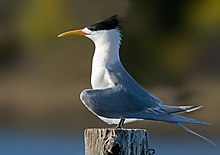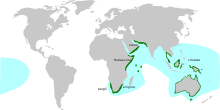വലിയ കടലാള
അഴിമുഖങ്ങളിലും കായൽ-കടൽത്തീരങ്ങളിലും കാണപ്പെടുന്ന ലാറിഡേ കുടുംബത്തിൽപ്പെട്ട ഒരു പക്ഷിയാണ് വലിയകടലാള.[3] കേരളത്തെ സംബന്ധിച്ച് ഇത് ഒരു ദേശാടനപക്ഷിയാണെന്ന കാര്യത്തിൽ തർക്കമുണ്ട്.[4]വടക്കൻ കേരളത്തിന്റെ ചില ഭാഗങ്ങളിൽ ഇതിന്റെ സാന്നിദ്ധ്യം സാധാരണവും തെക്കൻ കേരളത്തിൽ വിരളവുമാണ്.കൂട്ടമായി സഞ്ചരിയ്ക്കുന്ന കടലാള മത്സ്യങ്ങളേയും ചെറുപ്രാണികളേയും കൂടാതെചിലപ്പോൾ കടലാമക്കുഞ്ഞുങ്ങളേയും ആഹാരമാക്കാറുണ്ട്.[5][6].[7]അസാധാരണമായ ദൂരക്കാഴ്ച ഇരതേടൽ എളുപ്പമാക്കുന്നു.
| വലിയ കടലാള | |
|---|---|

| |
| Breeding plumage T. b. cristata displaying | |
| ശാസ്ത്രീയ വർഗ്ഗീകരണം | |
| Domain: | Eukaryota |
| കിങ്ഡം: | Animalia |
| Phylum: | കോർഡേറ്റ |
| Class: | Aves |
| Order: | Charadriiformes |
| Family: | Laridae |
| Genus: | Thalasseus |
| Species: | T. bergii
|
| Binomial name | |
| Thalasseus bergii (Lichtenstein, 1823)
| |

| |
| Approximate breeding range Wintering range | |
| Synonyms[2] | |
|
Sterna bergii Lichtenstein, 1823 | |
വിവരണം
തിരുത്തുകഇരുണ്ട ചാര നിറവുംകൊക്കിനു പച്ചകലർന്ന മഞ്ഞനിറവും ഉണ്ട്.പ്രജനനകാലം കഴിഞ്ഞാൽ ശിരസ്സിലെ കറുത്ത നിറം മാറി മുൻഭാഗം കഷണ്ടികയറിയതുപോലെ തോന്നും. വെളുത്ത നെറ്റിയിൽ പുള്ളികൾ ചിതറിയരൂപത്തിൽ കാണാം.[8] ചിറകുവീതി 125-130 സെന്റിമീറ്റർ ആണ്.[9]
വിതരണം
തിരുത്തുകഉഷ്ണ മേഖല- മിതശീതോഷ്ണ മേഖലയിലെ ദ്വീപുകളിലെ കടൽ തീരങ്ങളില്വലിഅ കൂട്ടങ്ങളായി കൂട് വെക്കുന്നു. തെക്കെ ആഫ്രിക്ക, ഇന്ത്യൻ മഹസമുദ്രം, പസിഫിക് സമുദ്രത്തിന്റെ മ്ദ്ധ്യ ഭാഗം ഇവയുടെ ചുറ്റും പ്രജനനം നടത്താറുണ്ട്.
പ്രജന സമയമല്ലാത്തപ്പോൾ തീരങ്ങളിലൊ വഞ്ചികളിലൊ സമീപ കെട്ടിറ്റങ്ങളിലൊ വിശ്രമിക്കും.[10]
പ്രജന നത്തിനുശേഷം ഇവ കൂട്ടം പിരിയുന്നു
പ്രജനനം
തിരുത്തുകമറ്റു പക്ഷികളുടെ കൂട്ടറത്തിലാണ് കൂട് വെക്കുന്നത്. ഇവയ്ക്ക് ഒരു കൊല്ലത്തേക്ക് ഒരു ഇണ മാത്രമെ ഉണ്ടാവൂ. ചില ഇണകൾ വർഷങ്ങളോളം തുടരാറുണ്ട്..[11]
ഏറ്റവും വലിയ പ്രജനന കൂട്ടം 13000-15000 ജോടികളെ ഉത്ത ആസ്ത്രേലിയയിൽ ഗൾഫ് ഓഫ് കാർപ്പൻടേരിയയിലാണ് രേഖപ്പെടുത്തിയിട്ടുള്ളത്.[12] ഇവ തുടർച്ചയായി പ്രജനന സ്ഥലം മാറാറില്ല. [13]
കൂട് വെക്കാൻ സ്ഥലം പൂവൻ തെരെഞ്ഞെടുത്താൽ ആ ഒരു ചെറിയ പ്രദേശത്ത് മറ്റു ആളകളെ കൊത്തിഓടിക്കും. മറ്റൊരു പൂവൻ എത്തിയ്യാൽ ശക്തിയ്യായി എതിർക്കും.പിടയാണെങ്കിൽ ഇണയാക്കാൻ ശ്രമിക്കും..[14]
തുറന്ന നിലത്ത് ചെറിയ കുഴിയാണ് കൂട്. കൂട്ടിൽ അപൂർവ മായി ചെറു കല്ലുകളൊ മത്യങ്ങളുടെ എല്ലുകളൊ കാണാറുണ്ട്.ഒന്നൊ രണ്ടൊ മുട്ടകൾ ഇടുന്നു. പൂവനും പിടയും അടയിരിക്കുന്നു. 25-30 ദിവസംകൊണ്ട് മുട്ട വിരിയുന്നു.[15] ഒരു കോളനിയിൽ ഒറെ സയത്താണ് മുട്ടയിടുന്നത്. [16] രക്ഷിതാക്കൾക്ക് അവരുടെ മുട്ടയൊ വിരിഞ്ഞ ഉടനെയുള്ള കുഞ്ഞുങ്ങളേയൊ തിരിച്ചറിയാനാവുന്നില്ല. എന്നാൽ വിരിഞ്ഞ് രണ്ടുദിവസംകൊണ്ട് പറ്റുന്നു.[17]
ഭക്ഷണം
തിരുത്തുകതൊണ്ടൂള്ള ജീവികളേയും പ്രാണികളേയും കഴിക്കുമെങ്കിലും മത്സ്യമാണ് പ്രധാന ഭക്ഷണം. [18]
വെള്ളത്തിൽ ഊളിയിട്ടാണ് ഇര പിടിക്കുന്നതെങ്കിലും വായുവിൽ വച്ചാണ് ഭക്ഷിക്കുന്നത്. പ്രജനന കാലത്ത് 10 കി.മീ. ചുറ്റളവിൽ ഇര തേടുന്നു. [18]
ഇവയുടെ നേത്രപടലത്തിന്റെ കോൺ കോശങ്ങളിൽചുവന്ന എണ്ണത്തുള്ളികൾ ഉണ്ട്. ഇത് ഇ വയുടെ കാഴ്ച മെച്ചപ്പെടുത്തുന്നു. [19] വെള്ളത്തിലും വായുവിലും കാണേൺറ്റതുള്ളതുകൊണ്ട് ഈ എണ്ണത്തുള്ളികൾ സഹായകമാണ്. [20]
കണ്ണികൾ
തിരുത്തുക- (Greater crested tern = ) Swift tern - Species text in The Atlas of Southern African Birds
അവലംബം
തിരുത്തുക- ↑ BirdLife International (2016). "Thalasseus bergii". The IUCN Red List of Threatened Species. 2016. IUCN: e.T22694571A93458063. doi:10.2305/IUCN.UK.2016-3.RLTS.T22694571A93458063.en. Retrieved 14 January 2018.
- ↑ Greater crested tern on Avibase
- ↑ Gill, F; Donsker, D (eds.). "IOC World Bird Names (v 2.11)". International Ornithologists' Union. Archived from the original on 2013-12-05. Retrieved 28 February 2012
- ↑ പക്ഷികേരളം. മാതൃഭൂമി ആഴ്ചപ്പതിപ്പ്. 2018.ഏപ്രിൽ 1-7 .പു 94
- ↑ Blaber, S. J. M.; Milton, D. A.; Smith, G. C.; Farmer, M. J. (November 1995). "Trawl discards in the diets of tropical seabirds of the northern Great Barrier Reef, Australia" (PDF). Marine Ecology Progress Series. 127: 1–13. doi:10.3354/meps127001.
- ↑ Cooper (2006) 760–764
- ↑ Blaber, S. J. M.; Milton, D. A.; Smith, G. C.; Farmer, M. J. (November 1995). "Trawl discards in the diets of tropical seabirds of the northern Great Barrier Reef, Australia" (PDF). Marine Ecology Progress Series. 127: 1–13. doi:10.3354/meps127001.
- ↑ Snow & Perrin (1998) 770–771
- ↑ Olsen & Larsson (1995) 35–42
- ↑ Carrick, R.; Wheeler, W. R.; Murray, M. D. (1957). "Seasonal dispersal and mortality in the Silver Gull, Larus novae-hollandiae Stephens, and Crested tern, Sterna bergii Lichstein, in Australia". Wildlife Research. 2 (2): 116–144. doi:10.1071/CWR9570116.
- ↑ Higgins & Davies (1996) 610–611
- ↑ Walker, T. A. (1992). "A record Crested Tern Sterna bergii colony and concentrated breeding by seabirds in the Gulf of Carpentaria". Emu. 92 (3): 152–156. doi:10.1071/MU9920152.
- ↑ Carrick, R.; Wheeler, W. R.; Murray, M. D. (1957). "Seasonal dispersal and mortality in the Silver Gull, Larus novae-hollandiae Stephens, and Crested tern, Sterna bergii Lichstein, in Australia". Wildlife Research. 2 (2): 116–144. doi:10.1071/CWR9570116.
- ↑ Fisher, James; Lockley, R. M. (1989). Sea Birds (Collins New Naturalist series). London: Bloomsbury Books. pp. 155–156. ISBN 1-870630-88-2.
- ↑ "Crested Tern". Fact Sheets. Australian Museum. Retrieved 5 July 2008.
- ↑ Dunlop, J. N. (1987). "Social-behavior and colony formation in a population of crested terns, Sterna bergii, in southwestern Australia". Australian Wildlife Research. 14 (4): 529–540. doi:10.1071/WR9870529.
- ↑ Davies, S. J. J. F.; Carrick, R (1962). "On the ability of crested terns, Sterna bergii, to recognize their own chicks". Australian Journal of Zoology. 10 (2): 171–177. doi:10.1071/ZO9620171.
- ↑ 18.0 18.1 Blaber, S. J. M.; Milton, D. A.; Smith, G. C.; Farmer, M. J. (November 1995). "Trawl discards in the diets of tropical seabirds of the northern Great Barrier Reef, Australia" (PDF). Marine Ecology Progress Series. 127: 1–13. doi:10.3354/meps127001.
- ↑ Sinclair, Sandra (1985). How Animals See: Other Visions of Our World. Beckenham, Kent: Croom Helm. pp. 93–95. ISBN 0-7099-3336-3.
- ↑ Varela, F. J.; Palacios, A. G.; Goldsmith T. M. (1993) "Vision, Brain, and Behavior in Birds" in Harris, Philip; Bischof, Hans-Joachim Vision, Brain, and Behavior in Birds: a comparative review Cambridge, Massachusetts: MIT Press 77–94 ISBN 0-262-24036-X
